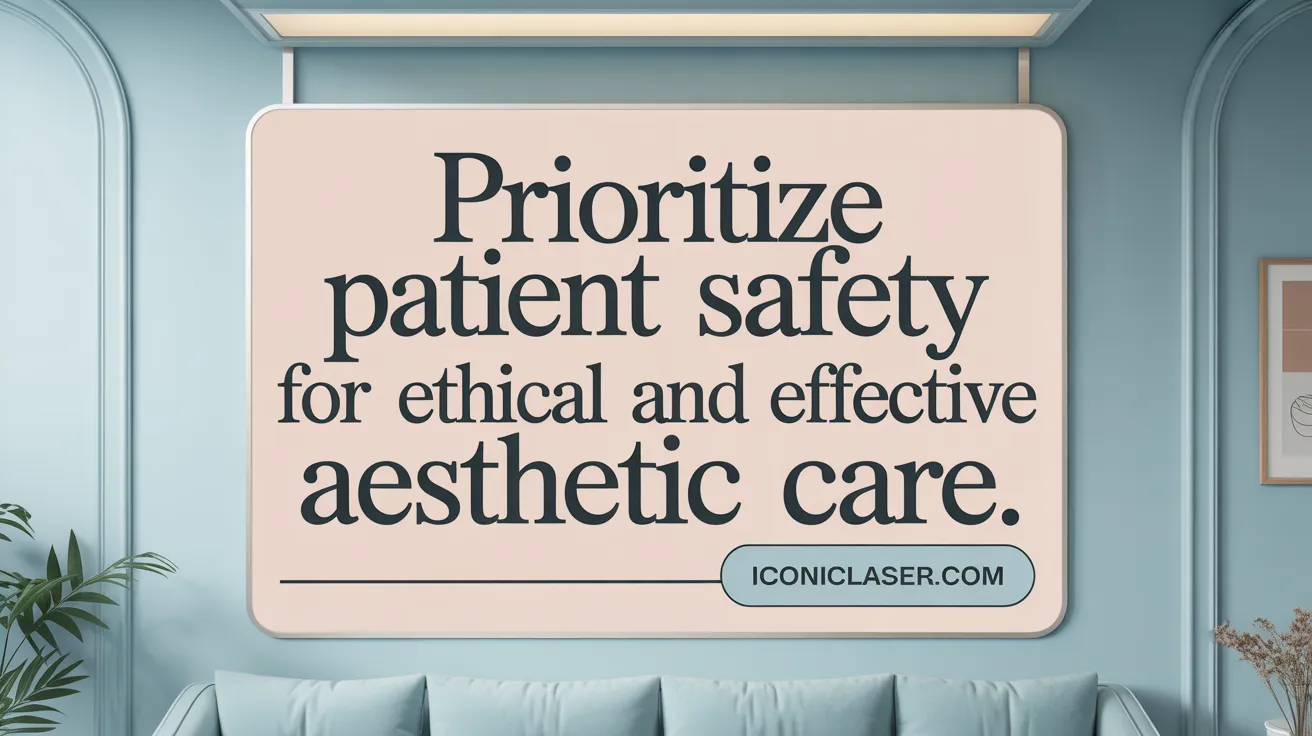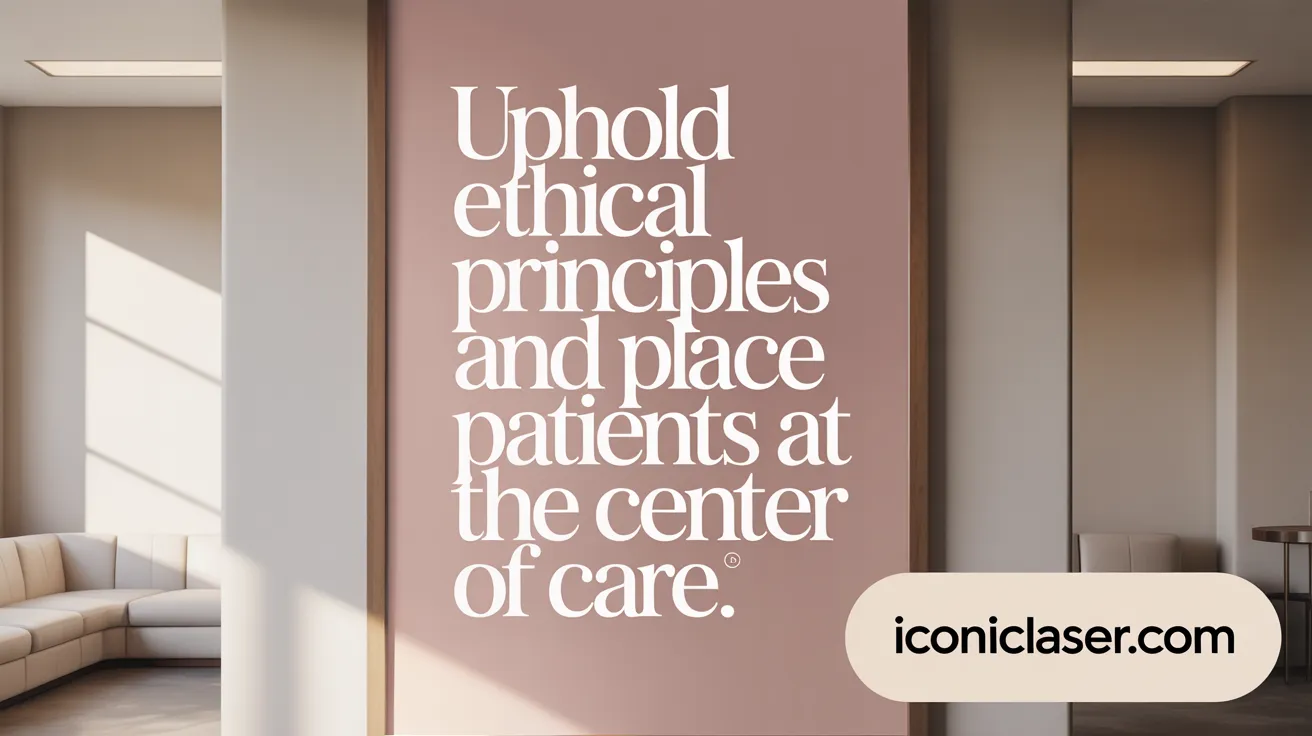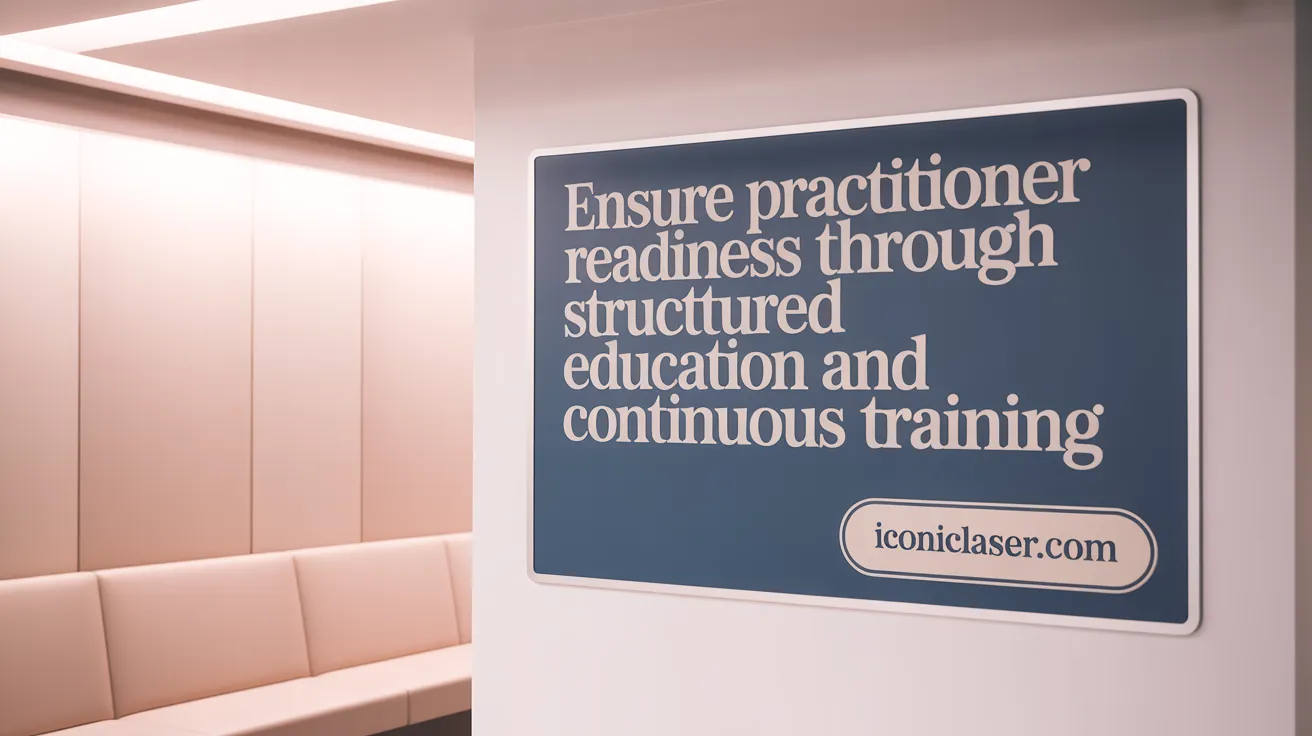The Critical Role of Safety in Medical Aesthetics
Medical aesthetic procedures offer transformative benefits but carry inherent risks that require vigilant safety measures. Prioritizing patient safety is essential not only to prevent complications but also to promote trust, ethical practice, and optimal results. This article explores the multifaceted approaches to safeguarding patients through best practices, training, ethics, evolving industry standards, and research-backed protocols.
Foundations of Patient Safety: Importance and Core Practices

Why is patient safety important in medical aesthetic procedures?
Patient safety forms the cornerstone of ethical and effective medical aesthetic care. It aims to prevent physical harm, adverse effects, and serious complications like infections, vascular occlusions, and even death. These risks can arise from technical mistakes, product issues, or inexperience of the practitioner. Ensuring safety involves thorough patient screening, obtaining informed consent, maintaining sterile environments, and following strict procedural protocols.
Pre-procedure screening includes detailed medical history documentation and allergy assessments. Recognizing potential allergies or health risks allows practitioners to tailor treatments properly and avoid severe reactions.
Informed consent is crucial; patients must understand the risks, benefits, and realistic outcomes of their procedures. Honest communication and setting proper expectations help prevent misunderstandings and dissatisfaction.
Maintaining strict aseptic techniques, such as proper sterilization of equipment and use of sterile gloves, significantly reduces infection risks. Training practitioners in aseptic procedures and ensuring clinics adhere to safety standards are vital.
Reporting complications and adverse events helps develop better safety protocols and improves industry knowledge. Choosing qualified, board-certified professionals working in accredited clinics further reduces risks.
Overall, prioritizing patient safety not only protects individuals but also sustains the trust and integrity of aesthetic medicine. It promotes better outcomes, fosters professional accountability, and supports continuous improvement across the field.
Guidelines, Protocols, and Standards Ensuring Safe Treatments

What are the best practices and guidelines for ensuring patient safety during aesthetic treatments?
Ensuring safety in aesthetic procedures begins with comprehensive patient assessments. Practitioners must review medical histories closely to identify allergies, contraindications, and previous reactions. Conducting physical examinations helps evaluate facial anatomy and skin condition, setting realistic expectations for results.
Proper training and certification are vital. Continuously updating knowledge through education programs focused on facial anatomy, current techniques, and safety management reduces risks. This ongoing learning is crucial as new products and methods emerge.
Strict aseptic techniques should be standard. This includes proper skin disinfection, wearing personal protective equipment (PPE), and sterilizing instruments. Using approved, reputable products minimizes adverse reactions. Clear communication prior to treatment, including explaining potential risks and obtaining informed consent, supports ethical practice.
Post-treatment, providing detailed instructions helps manage patient expectations and detect early signs of complications. Consistent documentation of procedures and patient responses not only supports legal compliance but also fosters quality assurance.
Staff training is an ongoing process. Regular refreshers on safety protocols, complication management, and new developments ensure team readiness. Implementing standard operating procedures (SOPs) guarantees consistent application of safety measures across all cases.
What safety standards and evaluation processes exist in aesthetic medical procedures?
Safety standards are rooted in strict regulatory compliance. Many regions require practitioners to hold proper qualifications, such as licensing and certification specific to aesthetic medicine. For instance, adherence to standards like EN 16844 in Europe sets benchmarks for product safety and procedural quality.
Practices should operate within regulated environments, often confirmed through accreditation by recognized bodies like the American QUAD A. These organizations verify facilities' compliance with high safety and hygiene standards, including room sterilization, air quality, and emergency preparedness.
Infection control remains a cornerstone. Protocols include rigorous disinfection, sterilization of instruments, use of PPE, and proper waste disposal. Regular staff skill assessments and adherence to SOPs underpin high-quality, safe care.
Monitoring of adverse events is also essential. Close patient follow-up allows early detection of complications such as allergic reactions, vascular occlusions, or infections. Maintaining detailed records of procedures and outcomes supports continuous review and quality improvement.
Legal and regulatory frameworks govern the qualifications and supervision of practitioners to ensure only qualified professionals perform these treatments. Using checklists like the WHO surgical safety checklist has been shown to reduce complications and improve patient safety.
In conclusion, adherence to international safety standards, comprehensive practitioner training, and diligent procedural protocols are critical to maintaining high safety levels in aesthetic medicine.
Ethical Principles and Patient-Centered Care in Aesthetic Medicine

What ethical considerations are important for safeguarding patient well-being in aesthetic medicine?
In aesthetic medicine, safeguarding patient well-being requires a strong ethical foundation. Practitioners must ensure informed consent is obtained, meaning patients fully understand the risks, benefits, and realistic outcomes of procedures. Transparent communication helps build trust and sets proper expectations.
Respect for patient autonomy is essential. Patients should be empowered to make decisions based on comprehensive information and their personal values. It is equally important for practitioners to prioritize patient safety through thorough pre-procedure assessments and managing expectations to prevent dissatisfaction or harm.
Avoiding procedures that are driven solely by societal pressures or superficial influences is critical. Ethical practice involves evaluating whether treatments are appropriate for the patient's health and psychological well-being.
Maintaining confidentiality and professional integrity safeguards patient trust and preserves industry standards. Practitioners must also stay vigilant about the influence of social media, which can create unrealistic beauty ideals and pressure patients into unnecessary treatments.
Conflicts of interest must be managed carefully. For instance, providers should disclose if they benefit financially from certain treatments, especially when working with vulnerable groups like adolescents or individuals with body image concerns.
Ultimately, patient-centered care rooted in beneficence (doing good), nonmaleficence (avoiding harm), justice, and ongoing ethical education are crucial. Upholding these principles ensures that aesthetic practices truly serve and protect patient interests, fostering trust and safety in this rapidly evolving field.
| Aspect | Consideration | Additional Details |
|---|---|---|
| Informed Consent | Full disclosure of risks and outcomes | Clear communication tailored to patient understanding |
| Patient Autonomy | Respect for patient's decisions | Ensuring choices align with informed preferences |
| Managing Expectations | Realistic goal setting | Using visual aids and honest discussions |
| Avoiding Societal Pressures | Ethical decision-making | Assessing motivations and psychological health |
| Confidentiality | Protecting patient information | Following privacy laws and guidelines |
| Social Media Influence | Oversight of external influences | Promoting healthy perceptions and resisting unattainable standards |
| Conflicts of Interest | Transparency in relationships and incentives | Disclosure of financial interests to prevent bias |
| Continuous Ethical Training | Ongoing professional development | Staying current with evolving standards and ethical practices |
This comprehensive ethical approach balances aesthetic ambitions with patient health, ensuring safe, respectful, and responsible care in medical aesthetics.
Comprehensive Training and Education for Practitioner Preparedness

How is training and education structured to ensure safety measures are properly followed by medical aesthetic practitioners?
Training and education in medical aesthetics are carefully structured to emphasize patient safety at every stage. Accredited courses serve as the foundation, combining theoretical learning with practical, hands-on experience. This approach ensures practitioners develop a thorough understanding of facial anatomy, injection techniques, and complication management.
A significant component of training involves detailed anatomy education, often through cadaver courses. This deep knowledge helps practitioners avoid dangerous zones such as blood vessels, significantly reducing the risk of vascular occlusions.
Beyond initial training, ongoing professional development is vital. Regular updates, mentorship programs, and participation in advanced courses allow practitioners to stay current with evolving techniques and safety guidelines. Continuous education ensures that safety protocols, like standardized operating procedures, are consistently applied.
Effective training also encompasses the development of robust safety protocols and standard operating procedures (SOPs) that promote uniformity in practice. These procedures guide practitioners through pre-treatment assessment, technique, and post-treatment care, helping prevent errors or adverse events.
Creating a culture centered on safety is essential. This involves fostering open communication and teamwork within clinics, empowering staff to voice concerns, and encouraging collaborative decision-making.
Finally, education encompasses the ability to recognize complications early and manage them promptly. Equipping practitioners with this knowledge ensures swift intervention, minimizes risks, and improves patient outcomes.
Overall, structured, accredited training programs, coupled with ongoing education and a safety-focused environment, are fundamental for ensuring practitioners follow safety measures diligently in medical aesthetics.
Evolving Industry Standards and Evidence-Based Practices Driving Safety Improvements

What industry protocols and evolving standards aim to minimize risks and complications in medical aesthetic treatments?
The industry is increasingly adopting comprehensive protocols and updated standards to prioritize patient safety in aesthetic procedures. These include adherence to rigorous clinical guidelines, use of standardized checklists, and thorough risk assessments before treatment. Legislation such as Oregon SB 951 and similar regulations in other regions have strengthened oversight, restricting non-physician ownership and demanding stricter registration and licensing, especially for blood-related treatments like Platelet-Rich Plasma (PRP).
Practitioners are now encouraged to perform procedures within sterile, medical-grade environments and rely on evidence-based techniques. Precise knowledge of facial anatomy, combined with advanced safety technologies, helps prevent complications such as vascular occlusions or infections. Moreover, mandatory face-to-face consultations and standardized training reinforce professional accountability.
These evolving standards also emphasize ongoing education, transparency, and patient awareness to avoid adverse outcomes, ensuring that procedures are performed by trained, licensed practitioners committed to best practices.
What are the latest research findings and evidence-based practices that promote patient safety in cosmetic treatments?
Recent studies highlight the importance of implementing evidence-based guidelines, safety protocols, and comprehensive patient education for minimizing risks. Organizations like the American Society of Plastic Surgeons (ASPS) have developed detailed recommendations on surgical techniques, postoperative care, and complication management, helping reduce adverse event rates.
Robust preoperative screening and detailed patient consultations are now standard to identify individual risk factors. The use of minimally invasive, targeted procedures also contributes to safety by limiting exposure to potential complications.
Additionally, legislation in countries such as Brazil and Korea incentivizes transparency through adverse event reporting, facilitating data collection that guides ongoing improvements. Continuous review of emerging scientific evidence and cross-disciplinary collaboration further bolster safe practices.
Together, these efforts support a culture of safety, where technology, research, and regulation converge to enhance outcomes and trust in aesthetic medicine.
| Aspect | Focus | Impact |
|---|---|---|
| Regulatory Legislation | SB 951, licensing, restrictions | Better oversight and practitioner accountability |
| Training & Education | Standardized programs, certifications | Expert competency, risk reduction |
| Safety Technologies | Sterile environments, advances | Vascular occlusion prevention, infection control |
| Research & Data | Outcome tracking, adverse event reports | Continuous improvement, evidence-based updates |
| Patient Engagement | Informed consent, education | Empowered patients, realistic expectations |
A Future Built on Safety and Trust
As medical aesthetic procedures continue to evolve and gain popularity, prioritizing patient safety remains the cornerstone of ethical and effective practice. Through rigorous screening, adherence to established protocols, continuous education, and a strong ethical framework, practitioners can minimize risks and enhance outcomes. The commitment to evolving standards, transparent communication, and evidence-based practices fosters a culture of safety that benefits both patients and providers. Ultimately, embracing these principles ensures that medical aesthetics advances with integrity, trust, and a steadfast focus on patient well-being.
References
- Patient Safety in Aesthetic Procedures: What to Know
- The Primacy of Ethics in Aesthetic Medicine: A Review - PMC
- Prioritizing Patient Safety: The APDerm Approach to Botox ...
- Facial Aesthetic Priorities and Concerns: A Physician and ...
- Enhancing Safety, Patient Experience and Outcomes in an ...
- Mastering the Art of Patient Safety in Aesthetic Procedures
- Patient Safety is a Priority Every Step of the Way at Top ...
